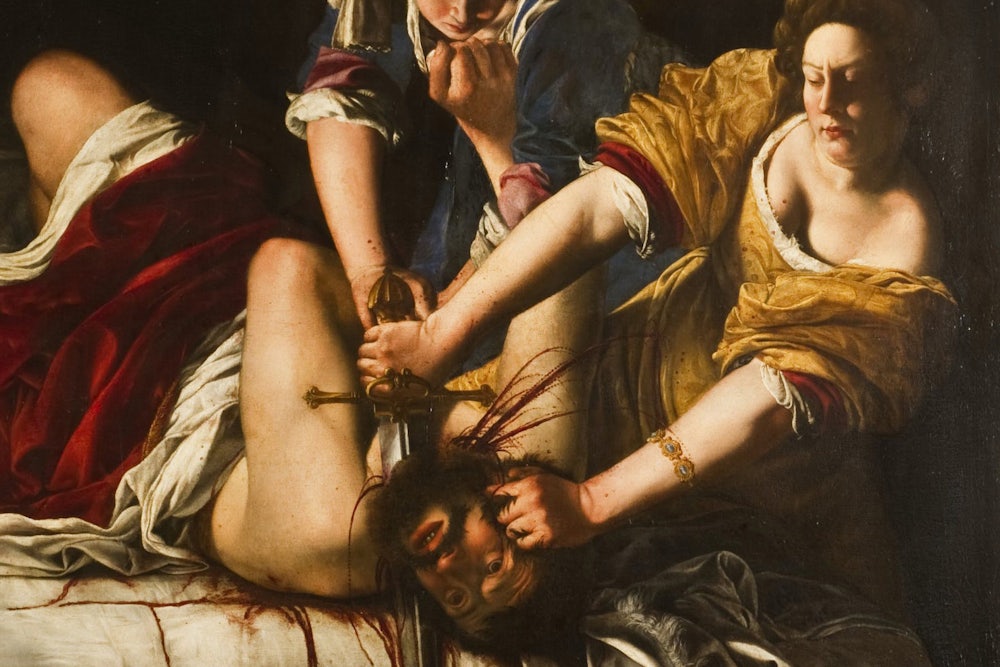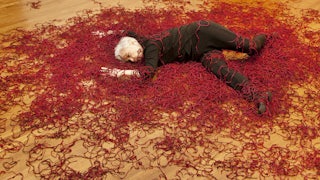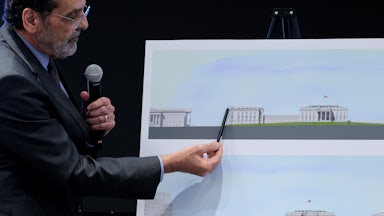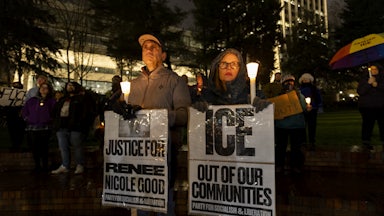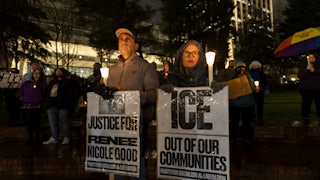In 1917, the Metropolitan Museum of Art received a stunning gift: a portrait by the French Neoclassical master Jacques-Louis David. The 1801 painting, titled Marie Joséphine Charlotte du Val d’Ognes after its subject, depicts a woman hunched over a drawing portfolio in a darkened room, looking out at the viewer with a studious gaze. The work came from a collector who paid $200,000 for it, a huge sum at the time. The Met trumpeted the acquisition in a press release, announcing that it would “henceforth be known in the art world as ‘the New York David,’” and indeed the painting was beloved by both audiences and critics.
Thirty years later, however, a problem arose. The art historian Charles Sterling discovered that the Met’s prized painting had been shown at the official Paris Salon of 1801—an exhibition that David had boycotted. This meant he couldn’t have made the work. In a museum bulletin, Sterling tentatively reattributed the portrait to a little-known female artist named Constance Charpentier. He justified the change by writing: “Meanwhile the notion that our portrait of Mlle Charlotte may have been painted by a woman is, let us confess, an attractive idea. Its poetry, literary rather than plastic, its very evident charms, and its cleverly concealed weaknesses, its ensemble made up from a thousand subtle artifices, all seem to reveal the feminine spirit.”
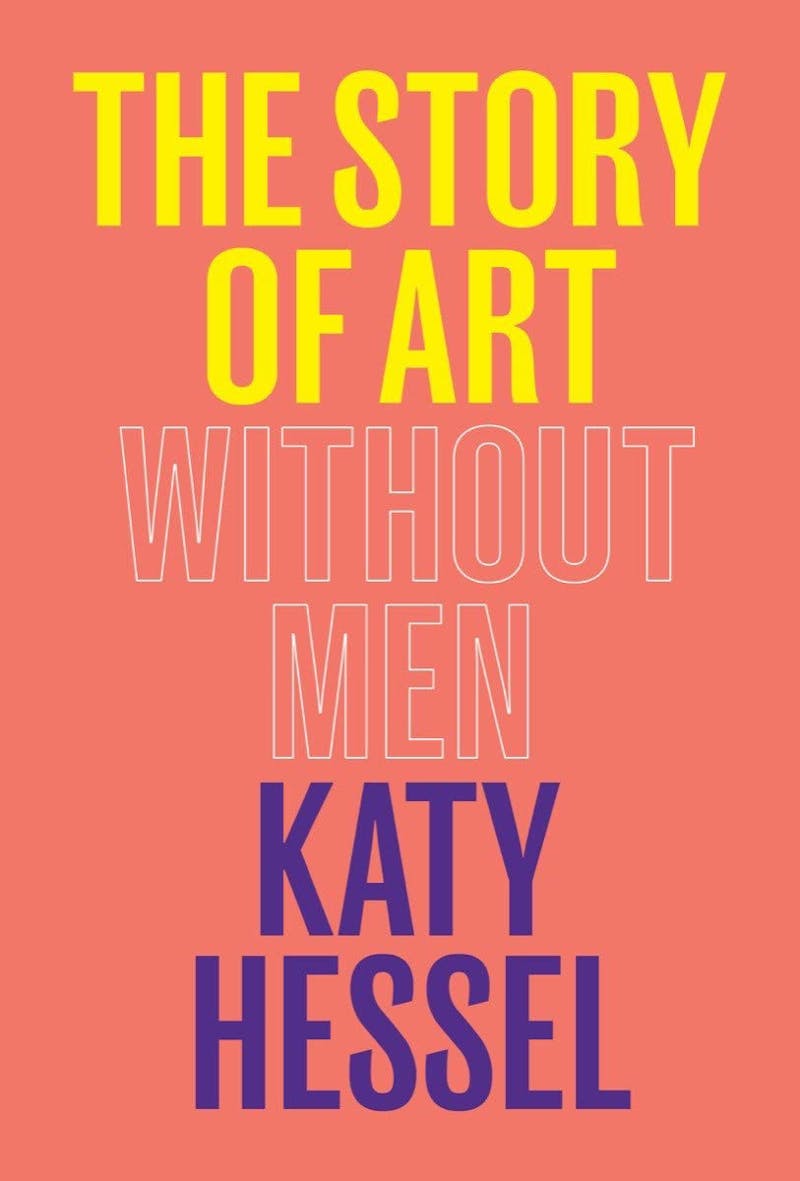
Despite the painting’s supposedly “feminine spirit,” the Met continued to display it with David’s name on the frame for another 30 years—that is, until the 1970s, when the second-wave feminist movement took up the cause of the work’s misattribution. Then, in 1995, a scholar named Margaret Oppenheimer made a new discovery: The portrait was by a different little-known female artist, Marie Denise Villers. The Met accepted the assignation, but “it is difficult to imagine historians praising a work to the same degree (or museums paying a similar price tag) had they known the author was a woman from the start,” writes Katy Hessel in her book The Story of Art Without Men. And to this day, we still don’t know much about Villers or du Val d’Ognes.
This tale is one of many maddening and instructive anecdotes in The Story of Art Without Men. The book is a feminist credo and a response to E.H. Gombrich’s The Story of Art, a more than 600-page bible of art history that discusses only a single woman artist. Hessel, who studied art history as an undergrad at University College London, set out to write a corrective to the male-dominated canon she’d been taught, by flipping the script: Her book builds a sweeping narrative by focusing solely on female and a handful of gender-nonconforming artists. “It feels important to remove the clamor of men in order to listen carefully to the significance of other artists to our cultural histories,” she writes. Of course, men do come up as fathers, teachers, lovers, and competitors, but they remain on the periphery.
This is an important correction, although not, it should be noted, a new one. Hessel’s particular version is tinged with the boosterism of girlboss feminism, which is perhaps not surprising for a book born out of an Instagram account, @thegreatwomenartists, also created by Hessel. Neatly packaged products like these answer loud, ongoing calls for more cultural representation. Yet they also run the risk of oversimplifying their subjects, grouping wildly disparate practitioners from different times and places under the bare header of “women”—or in this case, “not men.” It’s one thing to be seen; it’s another to have the freedom to make yourself understood.
There’s no doubt that, on some level, a book like The Story of Art Without Men is needed. Despite the increased visibility of female artists in exhibitions and other institutional programming, data on auctions and museum acquisitions shows that we remain a long way from parity. Art by men, particularly white men, still dominates collections and commands the highest prices. And despite the vigorous corrective efforts of the second-wave feminist movement of the 1970s, there’s still the problem of time. Men have been writing history for much longer than 50 years.
This is one of the telling lessons that emerges from Hessel’s book. As she moves across periods in art history and breaks them down into movements and media, she repeatedly finds tales of women who were successful in their times, only to be written out of history and forgotten, then recovered much later. One of the clearest examples is that of the Italian Baroque painter Artemisia Gentileschi, who was “an international celebrity” in her day.
The daughter of a successful artist, and the only female follower of Caravaggio, Gentileschi painted big, dramatic renderings of scenes from the Bible and mythology, which were popular at the time. She worked on the same scale as men and adopted Caravaggio’s hallmarks of realistic figures and chiaroscuro, an accentuated contrast of light and shadow, but took a different approach by focusing on the women at the center of many of these stories. In Gentileschi’s art, the women are not passive symbols, as men so often portrayed them, but active, psychologically charged subjects, like the Judith who furrows her brow as she grips the head of Holofernes and cuts it off. The first woman to be admitted to Florence’s Accademia delle Arti del Disegno, Gentileschi also became known for her keen self-portraits, depicting herself in various guises, including as the allegory of painting. Her incredible and unusual success as a woman—the Medici family were among her patrons—helped fuel demand for images of her.
But, Hessel notes, “when the Baroque age fell out of fashion in the mid-eighteenth century, her work was quietly forgotten,” mostly left out of scholarship written by men. It wasn’t until the 1970s and ’80s that her work was championed again, primarily by feminist scholars like Linda Nochlin and Ann Sutherland Harris, who included Gentileschi in their landmark exhibition “Women Artists: 1550–1950,” and Mary Garrard, who wrote the first monograph on her. In their catalog, Nochlin and Harris call Gentileschi “the first woman in the history of western art to make a significant and undeniably important contribution to the art of her time,” for her furthering of Caravaggio’s ideas and her protofeminist lens.
The recuperation of Gentileschi also brought a renewed focus on her early life: As a young woman, she was raped by Agostino Tassi, a painter and colleague of her father. After Tassi refused to marry her, her father sued him over the dishonor he brought on their family. The trial lasted seven months, throughout which time Gentileschi was tortured with a device made of ropes that were tied and tightened around her fingers, to prove that she was telling the truth. Tassi was found guilty and sentenced to exile, but the sentence was never enforced.
This story and the extant trial transcripts have captured the modern imagination: In recent decades, Gentileschi has become something of a symbol, her painted protagonists often viewed as self-expressions of fear and revenge (her rendering of Judith beheading Holofernes was widely shared on social media after the confirmation of Supreme Court Justice Brett Kavanaugh). But scholars today are starting to disentangle her art from her life and emphasize her technical abilities, as well as her remarkable independence and business savvy. In 2020, she was the subject of the National Gallery in London’s first (in 196 years!) major show dedicated to a woman artist, confirming her celebrity status once more.
Like Gentileschi, many of the pre-1900 women artists we know about today had artist fathers, or they came from the upper class—conditions that helped them overcome the strict patriarchal limitations of society. But their reputations suffered far more than those of their male peers in the long run. Rosa Bonheur, for example, was a hugely successful realist painter of animals: Her 16-foot-long The Horse Fair (1852–55) “is a painting so vivid, so lifelike, that when witnessed in the flesh, you can almost hear the hooves galloping across the earthly floor,” Hessel writes. After debuting at the Paris Salon, the work went on tour in England, where Queen Victoria requested a private viewing. Bonheur was trailblazing in multiple ways: She wore men’s clothing; had relationships with women; and was the first woman to receive the French Legion of Honor. But after Impressionism firmly displaced realism, it wasn’t until the late twentieth century and the publication of a landmark essay by Nochlin that Bonheur was partially recuperated.
The situation wasn’t much better for women who, rather than working in popular styles, helped pioneer new ones. Rococo artist Rosalba Carriera turned pastels into a beloved medium for the aristocratic and ruling classes in early-eighteenth-century France and Austria, but was later neglected. The Victorian botanist Anna Atkins made cyanotypes of algae that were groundbreaking both scientifically and aesthetically—she self-published the first book ever illustrated with photographs; yet Atkins only recently received her due for the achievement, which was eclipsed by William Henry Fox Talbot, a photography pioneer who published his own book eight months later (and from whom she learned about photographic processes). No wonder Hilma af Klint only showed her conventional paintings during her lifetime, stipulating that her abstract, spiritualist art not be seen for at least 20 years after her death in 1944; in 2018–19, her solo show broke attendance records at the Guggenheim.
Many of the careers and lives that Hessel traces ended early or abruptly. The French Impressionist Marie Bracquemond lived to be 75 but stopped making art by the time she was 50, because “her domineering and demanding husband,” in Hessel’s words, “so detested her expressive style … that he withdrew all emotional and financial support.” The German Expressionist Paula Modersohn-Becker died at 31, from complications of childbirth, after leaving and then returning to her husband. The queer couple Claude Cahun and Marcel Moore, both Surrealist writers and artists, were condemned to death for their resistance in Nazi-occupied Jersey, in the Channel Islands; though they were liberated before the sentence could be carried out, “they never recovered mentally,” Hessel writes. It’s impossible to read these stories without feeling haunted by the accumulated what-ifs, all the art that wasn’t but could have been.
As Hessel’s narrative progresses through the twentieth century and into the twenty-first, the injustices take a different shape. There are more cases, for instance, of men copying works by women and being given the credit. Consider the tale of Selma Burke, who in 1943 won a contest to sculpt a bronze relief of President Franklin D. Roosevelt. After he died in 1945, John Sinnock, the chief engraver of the U.S. Mint, made a portrait of Roosevelt for the dime that recalls Burke’s sculpture. “Outraged at the similarity, she demanded the FBI investigate this case,” Hessel writes. “Unsurprisingly, they did not, and Sinnock never credited her.”
Yet modernity and postmodernity also brought a proliferation of voices, including women’s. Certain societal restrictions—like European rules that kept women out of life-drawing classes until the end of the nineteenth century—were lifted, and rigid gender and racial hierarchies began to loosen. The results were more artists, more possibilities, more work, more media, and more firsts. One of the book’s most prominent themes is the way women and queer practitioners have expanded the boundaries of art by placing themselves in it. The British painter Gluck’s Medallion (YouWe) (1936) is a double portrait of the artist and their lover that Hessel identifies as “one of the first visibly Sapphic statements in Western art.” The Gee’s Bend Quiltmakers of Boykin, Alabama, turned the fabric leftovers of their lives into practical quilts with dazzling geometric designs. Performance artists like Marina Abramović and Ana Mendieta turned their bodies into raw material for their work.

These artists’ use of themselves goes beyond simple representation. They didn’t just create self-reflections; they claimed space through formal innovations and transformed commonly held understandings of what art was and could be. At its best, Hessel’s book makes clear how the story of art would not be the rich, eclectic, challenging one we know today if it had been reserved solely for men.
But who are we talking about when we say “men”—or “women,” for that matter? The failure to consider this question in depth saddles The Story of Art Without Men with a specious premise: that there is a single category of “woman,” within which everyone has some common experience of gender and its attendant oppressions. As numerous scholars and thinkers have explicated, that notion is too simple. “In a capitalist, racist, imperialist state there is no one social status women share as a collective group,” bell hooks wrote in her 1981 book, Ain’t I a Woman. Whether you’re Black, trans, disabled, queer, or straight, the way you move through and interact with the world is shaped by more than just your womanhood.
Hessel does acknowledge this by including a range of artists—of different races and ethnicities, those who were self-taught, and those who worked in often disregarded media like pottery or quilting. But her constant focus on gender, which begins as a rallying cry, ends up having a kind of homogenizing effect. “The bold women of Pop fought back” against the male-dominated movement “from a distinctly female perspective” (whatever that might be). Eva Hesse’s playful reliefs with soft, curving forms “not only subverted the angular nature of Minimalism but ... were no doubt made as a way to push through the perceived limitations of her gender.” Shirin Neshat’s series of confrontational photographs of Muslim women wearing hijabs “facilitates our understanding of the societal perceptions and expectations of women (in Neshat’s case, Muslim women in Western and non-Western countries).” Bharti Kher’s surreal sculptures of warrior women and goddesses “challenge the dominance of Eurocentric, male-led art.” None of these assertions is necessarily untrue, but with so little space devoted to each artist, they all begin to sound the same.
In fact, there are real and thorny differences among the artists included here and the conditions under which they labored. Take for example, the white artist Marie-Guillemine Benoist, whose 1800 painting of a Black woman Hessel features. The work originally bore the generic title Portrait d’une négresse, until the sitter was identified in 2019 as Madeleine, a servant brought by Benoist’s brother-in-law to Paris from the Antilles. Made during an interlude when France abolished slavery, the painting reflects a painful irony: In the words of the scholar Denise Murrell, whom Hessel cites, “Although the model is portrayed as emblematic of liberty, she can be assumed to have had little or no ability to influence the manner of her portrayal.” Both painter and subject are women, but with vastly different means and access to self-expression. And notably, beyond the discussion of Madeleine’s portrait, Hessel gives almost no consideration to race in this period.
It doesn’t help that Hessel’s later efforts at inclusion often feel clumsy, like she’s trying to shoehorn outsiders into a master Western narrative. For example, Hessel begins her chapter on the nineteenth century by discussing European Realist painters, before asking if women are “only able to achieve greatness when they emulate successful men.” She uses the inquiry to segue into artists “working on smaller scales, and some in alternative media, from the traditional establishment”—but whose tradition and whose establishment? The next subsection jumps to quilting in the United States, followed by brief interludes on the Hopi-Tewa potter Nampeyo, the Native and African American sculptor Edmonia Lewis, and the Japanese ukiyo-e artist Katsushika Ōi. From there the story resumes in England. The overall effect for the reader is jumbled, as if we’ve taken a detour but are now back on track.
For the most part, the artists from outside the United States or Europe who are included are those who have been sanctioned by the West. Hessel includes the Aboriginal Australian artist Emily Kame Kngwarreye in the 1990s chapter, for instance, because that’s around when she began making acrylic paintings that became widely popular. Yet Kame Kngwarreye, who died in 1996, had created ceremonial paintings and batiks for years before then.
Part of the problem lies in the structure of the book: Hessel is attempting to subvert the canon while also relying on it as a guide. It would be unfair to expect her to solve all the problems of feminist art history in one book, and I don’t. But I daresay that attempting to re-create Gombrich’s famously sexist text under the guise of inclusivity is not the best way to address art’s gender problems. There are better ways to write feminist art history: Monographs and single-artist studies create their own issues of valorization, but they can provide much more context. Biographies of specific groups, like Mary Gabriel’s Ninth Street Women, can be both more holistic and more complex. Landmark essays, like Linda Nochlin’s “Why Have There Been No Great Women Artists?” from 1971 and Lorraine O’Grady’s “Olympia’s Maid” from 1992–94, rigorously grapple with specific art historical problems.
And if we must have more reference texts, why not make them genuinely integrated? The truth is that men, women, and nonbinary people have almost always worked alongside and in conversation with one another, whether Judith Leyster and Frans Hals during the Dutch Golden Age or Lee Krasner and her husband, Jackson Pollock, during the postwar years of Abstract Expressionism. I want stories of art that grapple with the problems of patriarchy but see beyond them, too.
At its best, a book like Hessel’s might serve as a primer—a starting point from which to find out more about some of the women she includes. But in that case, the least I ask is accuracy, and I’m not entirely sure that it delivers. A big red flag came for me when, in the 1990s chapter, I read that Republican Senator Jesse Helms “decried Robert Mapplethorpe’s explicit homosexual photographs and in response defunded the National Endowment for the Arts.” This is wrong; Helms was a major player in the culture wars of the ’80s and ’90s in the United States, but he did not defund the NEA.
That error sent me searching through the book, wondering about small things that had been nagging at me. Ultimately, I landed back at the beginning, at the opening anecdote that’s become a bit of lore in media coverage of Hessel: “In October 2015, I walked into an art fair and realized that, out of the thousands of artworks before me, not a single one was by a woman.” That sentence had bothered me since I first read it. I didn’t understand how one could walk into an art fair and just ... realize that none of the thousands of artworks on view was by a woman. It would take a lot of research and reporting to confirm such a hunch. So, I did my own research. A Harper’s Bazaar piece identifies the fair as Frieze Masters, but several articles—including another one in Harper’s Bazaar—mention artwork by women on view there in 2015. Who is mistaken, me or Hessel?
This uncertainty concerns me because I’m a journalist—I think that getting the facts right matters. But it also bothers me because this supposedly sexist fair is Hessel’s entire feminist art history origin story. She goes on to write in the book’s introduction: “The night of the art fair I couldn’t sleep. Frustrated and angry about what I’d just witnessed, I typed the words ‘women artists’ into Instagram. Nothing happened. And so, @thegreatwomenartists ... was born.” To me, this reads like a parable about going on a well-intentioned but often self-congratulatory crusade. The thing is, just because you’ve discovered a problem doesn’t mean it’s new. And just because no one’s solved it yet doesn’t mean you have the solution.
